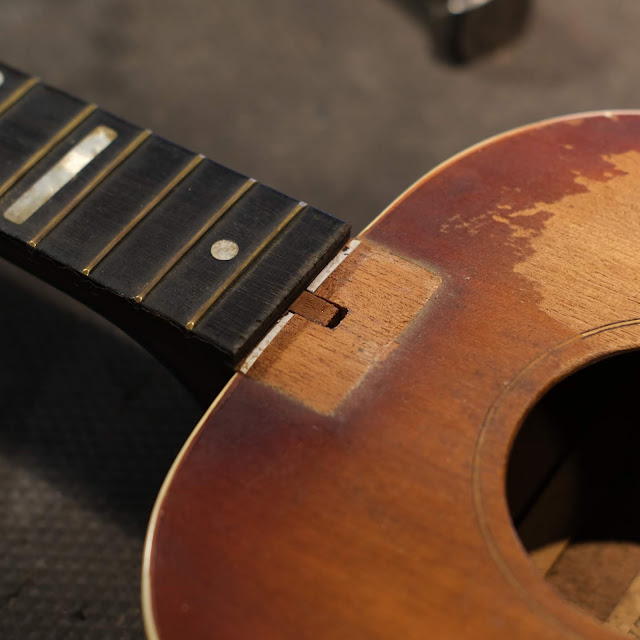Workshop: Two Odd Neck Joints
First-up is a Vega Solo Lute (baritone ukulele) which I've (since shooting this) converted into a tenor guitar (it's holding-up great). I knew that these didn't have a "normal" neck joint, so I removed the fretboard extension to scope it out before resetting the neck. These guys just have this tiny little tenon joint. It's amazing they hold-up so well over the years! Suffice to say when I reset it I also bolted the heel internally, too.
Next-up is a real pain in the butt joint. This is an 1890s-era bowlback mandolin (Bruno-branded) that uses no joint (tenor or dovetail) to attach the neck. In the case of this instrument, the neck is also the neck block that the ribs of the back (and bottom of the top) are glued on.
The ebonized fretboard was falling-off, pretty much, and in pieces -- so I simply removed it. You can see a small rectangular strip of chiseled-out spruce top near where the neck joins the body where I was making sure it was the kind of joint I thought it was (there would have been a telltale gap if it'd turned-out to be a dovetail joint hidden under the top wood).
Unfortunately, bowlbacks like this have very little value so the process of removing the neck+neckblock and resetting the whole thing by gluing-up the bowl again is a nutso idea for repair time. It'd cost far less to just buy a nicer bowlback for $200-300.
So, in the case of this instrument, it's a "fingers-crossed" repair to set the neck angle back so that action doesn't have to be a mile high over the body.
What I did was cut+drill out a 1/4" slot into the neck+neck block right where it joins the body (it's hidden by the fretboard extension). I then used my neck reset heater rod (on my soldering iron) to heat up that part of the wood, dripping-in a little water now and then for about 20 minutes to steam it up without excess water going everywhere. Eventually the wood was more flexible.
I then drove maple wedges into the slot and bent the heel area back from the "neck block" area while it was pliable. This is at the point you're seeing above.
Anyhow, this has given me a straight fretboard from the neck over the body extension and while I will have a lower bridge on the instrument after it's fixed, it will be perfectly playable. As it was, action was nearly 1/4" around the 12th fret and the fretboard extension ski-jumped quite a bit.



Comments